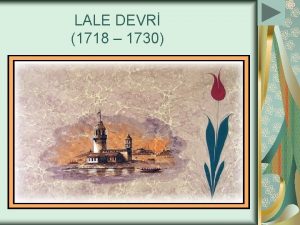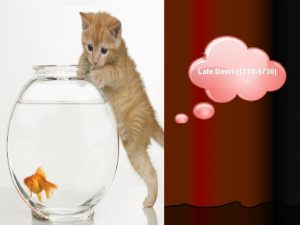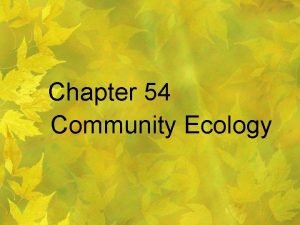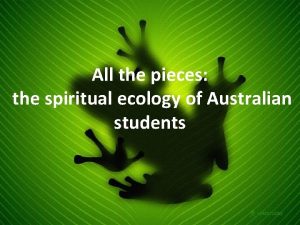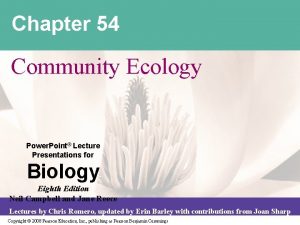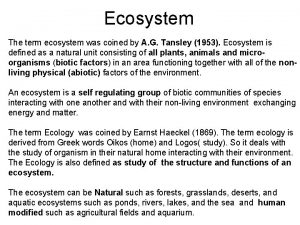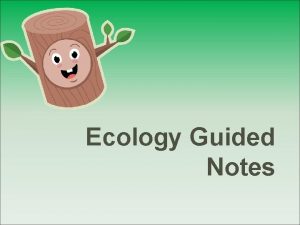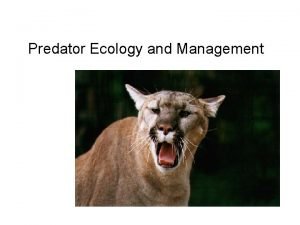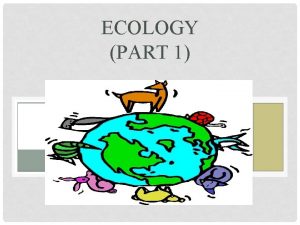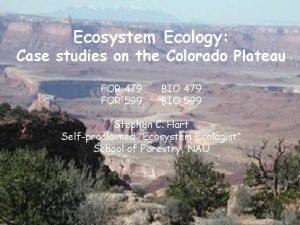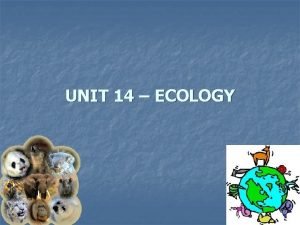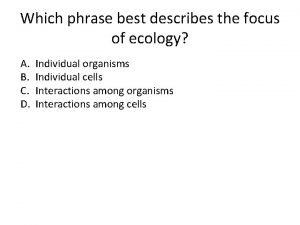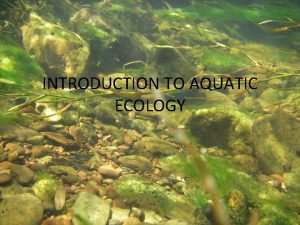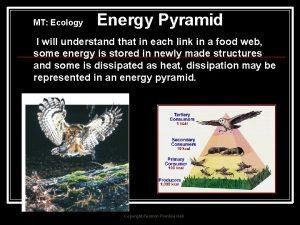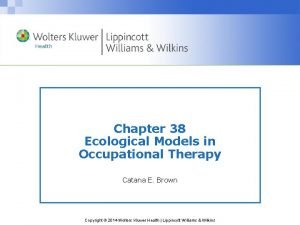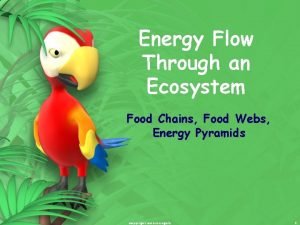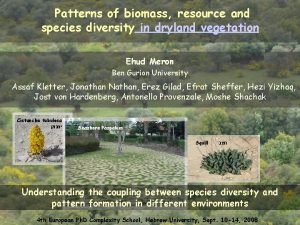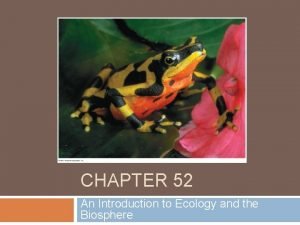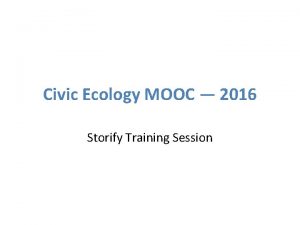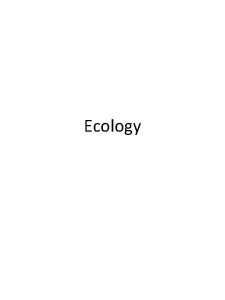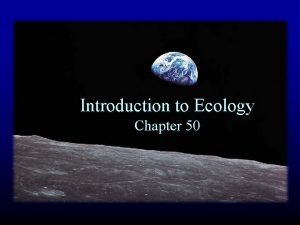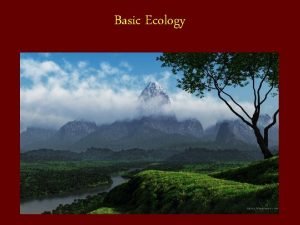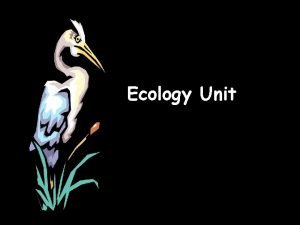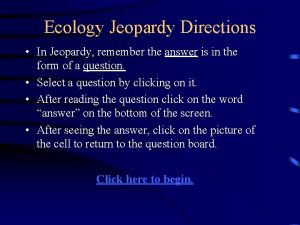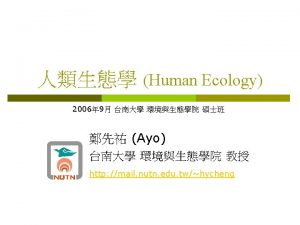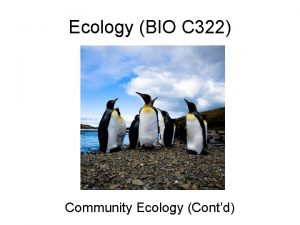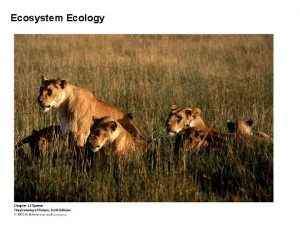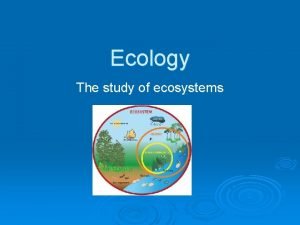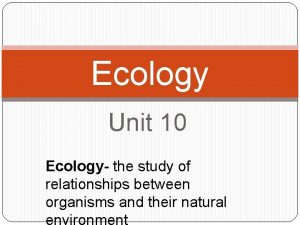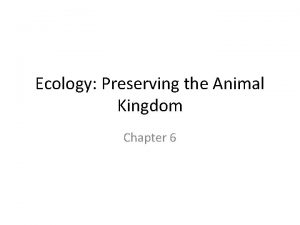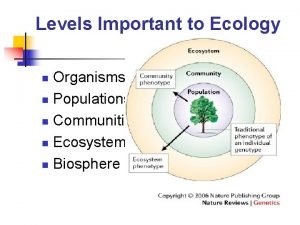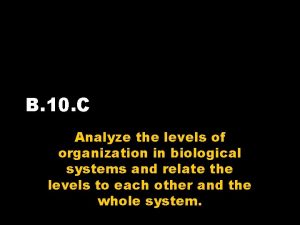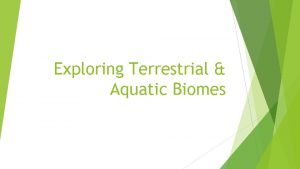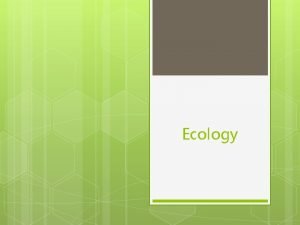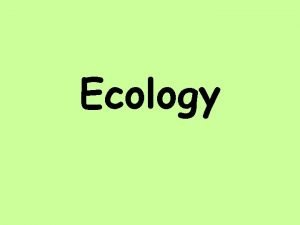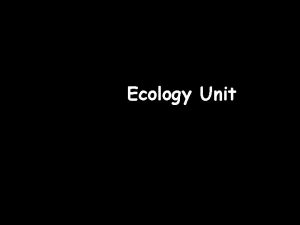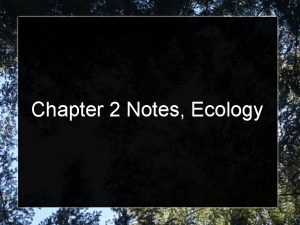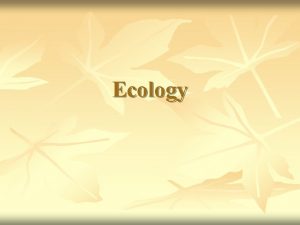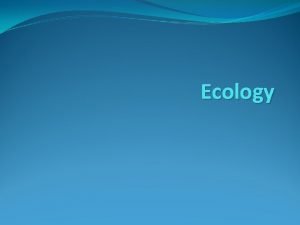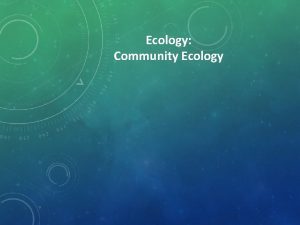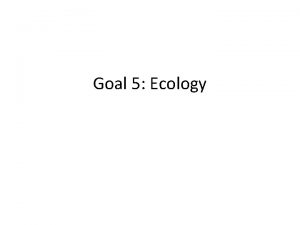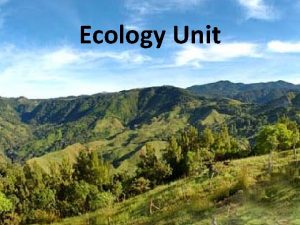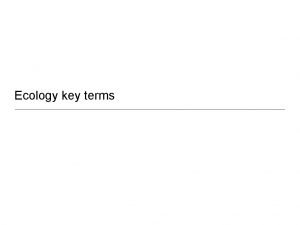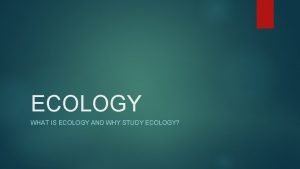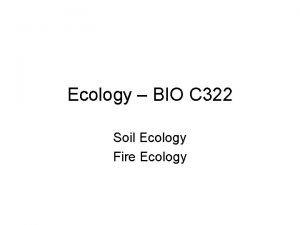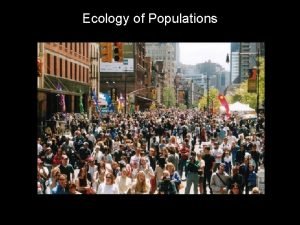CH 16 1718 Ecology What is Ecology Ecology

















































- Slides: 49

CH. 16, 17&18 Ecology

What is Ecology? Ecology is the study of the interactions between livings things and their environment.

Levels of Organization of Living Things- From smallest to largest Organism- one individual organism is the most basic level Population- a group of organisms of the same species that live in a particular area. Ex: the students in this class are a population. Communities- all the populations in an area. Ex: all the students in this school are a community.

Levels continued Ecosystem- all the living and nonliving things in an area. Ex: all the people, cars, buildings, pets, wildlife in Los Banos Biosphere- The portion of the Earth that supports life. Abiotic factors- nonliving parts of the biosphere that affects living things. – water, air, temperature, soil, light Biotic factors- living things that affect other living things – predators and competitors.

Biosphere Ecosystem Community Population organism

The Biology of Populations What is a Population? All the individuals of a species that live together in one place at one time. Population size- the number of individuals in a population. Population density- the number of individuals of a population living in a particular area. The more dense the population, the more competition there is between individuals. Carrying capacity- the maximum number of individuals that an environment can support

Patterns of dispersion: the way individuals are placed in an area. – Random distribution- individuals randomly choose where they want to be in an area. – – Ex: weeds in a field Even distribution- individuals are located as regular intervals. – – Random Ex: birds on a telephone wire. Clumped distribution- individuals live bunched together in family groups. Ex: a pride of lions or herd of buffalo. Clumped

Population Growth Life-history patterns- the length of time it takes for an individual to become sexually mature. This affects how the population will grow. – Rapid life-history (r-strategists)- these organisms are small, mature quickly, and reproduce early in life, and have a short life span. Ex: flies, bacteria – Slow life-history (k-strategists)- these organisms mature and reproduce slowly and life relatively long lives. Ex: whales, elephants, trees, humans

Population Growth Rates Growth rate- a population has to have enough members to limit inbreeding, but if the population gets too big, the individuals within will have to compete with each other for resources. – Exponential growth- the growth of the population starts off slowly but then grows very rapidly. more births than deaths. A graph of exponential growth would be J-shaped – Logistic model- the population grows exponentially, but levels off as it approaches the carrying capacity. Initially more births then birth =death rate

Population Carrying capacity J curve S curve Time FOOD PREDATORS Exponential growth SPACE DISEASE Graphing Growth Rates

Factors that affect growth rate – Density-dependent factors- as the population gets bigger, these factors have more of an impact on the individuals within. Ex: disease, competition, predators. – Density-independent factors- these are factors that affect a population no matter how many individuals there are in it. Ex: natural disasters like volcanoes, temperature, drought

How populations evolve Hardy-Weinburg principle: Frequency of alleles in a population do not change unless evolutionary forces act on the population. Mutation: Happen very slowly and may or may not affect or change the amino acid sequence produced. Gene flow: movement of individual (migration) in and out of a population. – Immigration: into a population – Emigration: out of a population Genetic drift: random change in allele frequency in a population. – Loss of individual changes alleles available in population Non random mating: random mating insures fitness

Distribution of traits Normal: polygenic traits have a range of phenotypes. Directional selection: eliminates on extreme from the population thus shifting the curve. – Anteater Stabilizing selection: elimination of extremes at both ends the intermediate phenotypes increase. – Lizard size

Nutrition and Energy Flow- All living things need energy to live. Autotrophs (producers)- Some Autotrophs capture energy from the sun and make their own food. Some autotrophs use chemicals through chemosynthesis. – – Other organisms consume autotrophs for energy. Examples: plants, photosynthetic algae and some bacteria.

Energy Flow Heterotrophs (consumers)- these organisms must consume other organisms to get energy. – Examples: people, dogs, fungi, some algae and some bacteria.

Types of Heterotrophs – Herbivores- organisms that only eat plants. – – Carnivores- organisms that eat meat. – – Chimpanzee, grizzly, human, some bats Scavengers - organisms that eat dead organisms. – – lions, wolves Omnivores-organisms that eat plant & animal – – horses, sheep vultures Decomposers- organisms that cause the decay of dead things. – When an animal dies, bacteria and fungi start to break down its body parts. After a while, all that is left is a skeleton.

Flow of Energy and Matter Food Chains- a simple model scientists use to show energy flows through an ecosystem. Energy always flows from autotrophs to heterotrophs. berries → mice → black bear Food webs- Since the interactions of organisms are much more complex than a simple food chain can show, many scientists use webs.

A desert Food Web Hawk Bush fox quail jackrabbit ferret tortoise cactus roadrunner Kangaroo rat insects Horned lizard toad lizard Rattle snake

Energy Pyramid- a model showing how much energy each level has. Energy is lost as you move up the pyramid. Autotrophs harness the most energy, herbivores are next, and carnivores are last. 90% of the energy is lost as you move up the pyramid. Trophic Level- Each level on the energy pyramid is a trophic level. Tertiary consumer Secondary consumer Primary consumer producer 1 10 1000

Organisms in Ecosystems- Organisms fit into their habitat in a specific way. Habitat- the place where an organism lives.

Niche- all the strategies and adaptations a species uses to live.

Ranges of Tolerance- the amount of change an organism can withstand. Ex: you can tolerate a specific range of temperature. If it gets too hot or too cold, you die! – Generalists have broad niches: they can tolerate a range of conditions and use a variety of resources. Opossum: found everywhere in the US & eats almost anything. – Specialists have narrow niches : limited conditions and few resources. Koala, found only in Australian outback & feed on eucalyptus trees.

Life in a Community- all organisms are affected by factors such as other organisms and even the non-living parts of the environment. Limiting factors- any living (biotic) or nonliving (abiotic) thing that affects an organism. Ex: water, sunlight, predators, food sources & breeding ground.

Symbiosis- the interactions between living things. Mutualism- a relationship where both organisms benefit. – Example: You have bacteria that live in your large intestines that produce vitamins B and K for you. You give the bacteria food and a safe place to live.

Commensalism- a relationship where one organism benefits and the other is neither harmed nor helped. Example: There are tiny bugs that live on your skin, no matter how much you wash. They don’t hurt you, but you provide housing and food for them. Clown fish & anemone

Parasitism- a relationship where one organism is harmed (host) and the other is benefited (parasite). – Endoparacites: live inside the host – Ectoparacites: live outside on the body Example: You can get intestinal worms (endoparacites) from undercooked meat. They live in your small intestine and feed on the food you eat. They cause damage by consuming the nutrients you were supposed to get when you ate.

Predation : predator captures, kills & consumes another individual, the prey. – Survival depends on adaptations for both. Predator: smell, sight, stalking Prey: camouflage, mimicry, speed & agility, false coloring. plants have sharp leaves, thorns, tough leaves, even irritating or poisonous compounds.

predator/Prey adaptations Mimicry : developing color patterns or shapes that resemble other things.

Figure 1: all of the frogs across the top are believed to be members of the species D. imitator. All of the frogs across the bottom are different species. From left to right: D. variablis, D. fantasticus and D. ventrimaculatus. Poisonous frogs mimics

Which is poisonous?

Mimicry

Mimicry

Coevolution: adaptation of 2 species to each others characteristics. – Birds beak shaped to only pollinate certain flowers. Narrow niche

Type of relationship?

Type of relationship?

Type of relationship?

Type of relationship?

Cycles in Nature Many of the basic building blocks in nature are not created or destroyed, they are simply recycled throughout time. The water cycle- All life depends on water. Condensation Evaporation Precipitation Transpiration Runoff Evaporation Oceans Groundwater

The carbon cycle- All living things have carbon in them. Open burning Atmospheric CO 2 Photosynthesis Respiration Photosynthesis Fuel Combustion Dissolved CO 2 Respiration Death and decay Fossil fuels

The nitrogen cycle- Nitrogen makes up 78% of the air you breathe. Nitrogen is also important in soil. Nitrogen in the atmosphere Some excess nitrogen evaporates from soil. Dead plant matter Urine from Decomposing animals organisms Assimilated by plants Nitrogen-fixing bacteria in the nodules on roots of leguminous plants fix atmospheric nitrogen. Nitrogenfixing soil bacteria Released to the atmosphere Nitrogen compounds released into soils and acted upon by soil bacteria Decomposers—bacteria and fungi— break down tissues and wastes and nitrogen-containing compounds are released. Converted to other nitrogen compounds by soil bacteria

Succession- changes that take place in a community over time. Ex: It doesn’t take very long for life to come back after a major flood or fire. – Primary Succession- takes place when life starts developing where there was NO life before. Ex: When a volcano erupts, it destroys all life near it. But after a few months, lichen start to grow and chew up the lava, turning it into soil. After a year, small plants appear. Within a decade, shrubs and young trees, as well as small animals can live in the path of the lava flow.

Primary Succession Moss Lichen Exposed rock Secondary succession Pioneer species Primary succession Climax community

Secondary Succession- takes place when life starts in a community that has been severely disrupted. Ex: When Hurricane Katrina flooded the marshlands in Southern Louisiana, most of the animals and some plants where washed away. It didn’t take long for life to repopulate because there was still soil for plants to grow. Another example is how the land looks after farmers cut all their corn down. There is soil, so weeds quickly take over.

Secondary succession Because soil already exists, secondary succession may take less time than primary succession to reach a climax community.

Biomes of the world Large ecosystem that contains smaller but related ecosystems within them. Biomes have similar climates (temperature & precipitation) and tend to have similar organisms with similar adaptations. 7 major land biomes 2 major water biomes

Biomes


Fresh Water biomes zooplankton Littoral zone: Shallow zone Grasses and small organisms like amphibians, insects Profundal zone: Deep water zone: no light Limnetic zone: Close to shore & surface Bacteria & worms break down decay Algae, zooplankton

Salt water biomes
 1718 1730
1718 1730 1718 1730
1718 1730 Oikos meaning
Oikos meaning Microbial ecology definition
Microbial ecology definition Objective of ecology
Objective of ecology Chapter 54 community ecology
Chapter 54 community ecology Population ecology section 1 population dynamics
Population ecology section 1 population dynamics Trophic level pyramid
Trophic level pyramid Bio spiritual ecology
Bio spiritual ecology Progressive succession examples
Progressive succession examples More diverse
More diverse Clumped dispersion
Clumped dispersion Ecological pyramids were first devised by
Ecological pyramids were first devised by Ecology guided notes
Ecology guided notes Shark
Shark Ecology part 1
Ecology part 1 Ecology terms
Ecology terms Parasitism
Parasitism Which phrase best describes the biosphere
Which phrase best describes the biosphere Aquatic ecology definition
Aquatic ecology definition Energy pyramid example
Energy pyramid example Ehp occupational therapy
Ehp occupational therapy Primary consumer ecology
Primary consumer ecology Shnerb ecology
Shnerb ecology Chaparral climograph
Chaparral climograph Objectives of ecology
Objectives of ecology Mooc ecology
Mooc ecology Ecology meaning
Ecology meaning Tropical grassland
Tropical grassland Unit 5 ecology
Unit 5 ecology Clumped dispersion
Clumped dispersion Four levels of ecology
Four levels of ecology Ecology unit review
Ecology unit review Chapter 4 section 1 population dynamics answer key
Chapter 4 section 1 population dynamics answer key Ecology jeopardy
Ecology jeopardy Oikos meaning in ecology
Oikos meaning in ecology Human ecology
Human ecology Neutralism biology
Neutralism biology Ecosystem ecology
Ecosystem ecology Taxis animal behavior
Taxis animal behavior Level of organization in ecology
Level of organization in ecology Unit 10 ecology
Unit 10 ecology Whats a climax community
Whats a climax community Keystone species definition and example
Keystone species definition and example Ecology preserving the animal kingdom
Ecology preserving the animal kingdom Population ecology
Population ecology Principles of ecology chapter 2 section 1 answer key
Principles of ecology chapter 2 section 1 answer key A student is studying the ecology of a playa lake
A student is studying the ecology of a playa lake Ecosystems interactions
Ecosystems interactions What biome has bison
What biome has bison
